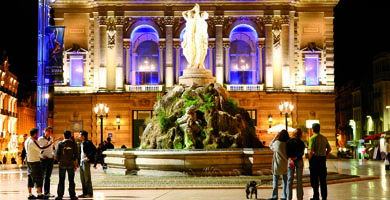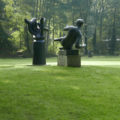ENGLAND: Westward Ho!
Michael Webb explores the historic and ancient treasures of England’s western countryside.
It’s easy to mock Masterpiece Theater and Downton Abbey for their idealized portrait of English country life. In the sprawling cities of the south, cars and asphalt prevail, and the generic suburbs seem endless. Growing up in London I spent many weekends braving traffic jams and the inevitable showers to explore architectural treasures and search for a rural paradise. Now, in southern California, I’m nostalgic for those expeditions. In September, I rented a car in London and set off for the western counties, hoping to find traces of what I remembered. A few hours on the freeway took me to Wiltshire and Gloucestershire, Shropshire and Herefordshire, Somerset and Dorset. There, I found expanses of idyllic countryside where little seemed to have changed since the age of the horse-drawn plow. My GPS directed me into a maze of narrow lanes that often resembled leafy tunnels, burrrowing through forests and farms to land me in a picture-perfect village or a stately home and its manicured estate.
My first stop was Cuddesdon, a hamlet outside Oxford, where Ripon Theological College commissioned an oval chapel from architect Niall Mclaughlin. Inspired by a tenth-century church in Venice, which resembles an upturned hull and was constructed by boat-builders, he created a springy vault of laminated wood ribs that filter light from the upper-level glass. Completed this year, it’s an oasis of serenity—one of many delights scattered in the countryside around the over-trafficked city of Oxford.
On to Coalbrookdale, which was a place of pilgrimage for artists and engineers in the 1770s when Abraham Darby built his Iron Bridge over the Severn Gorge. It was one of the first triumphs of the Industrial Revolution, a marvel of strength and lightness, as astonishing to contemporaries as was the Golden Gate Bridge 150 years later. South to the market town of Ludlow, which is full of half-timbered Elizabethan buildings, bulging out over narrow streets. The Feathers Hotel is a showpiece; but, as a place to stay, I would recommend Fishmore Hall, a Georgian house with stylish modern rooms and award-winning cuisine. Ludlow is a gastronomic hub and hosts a food festival in September.
Early next morning to my favorite small church: St Mary’s in the village of Kilpeck. Built of hard sandstone that has withstood a thousand years of wind and rain, it was too remote to be improved or restored. Local masons were given a free hand to create a gallery of tiny heads around the cornice and writhing figures on the portal, inspired by illuminated manuscripts or lively imaginations. Weathered tombstones lean at odd angles and the fields are full of grazing sheep. It’s a peaceful place, lost to the world. In contrast, the massive tower of Tewkesbury Abbey dominates the town of that name, and the interior is an enchanted forest of Norman piers, Decorated rib vaulting and delicate Gothic canopies over the tombs of local landowners. You could spend half a day exploring the riches of this monastic abbey turned parish church.
Half the great houses of Britain are lovingly maintained by the National Trust, and one of the grandest is Montacute, an Elizabethan mansion of lichened stone, with richly furnished rooms, and an exuberant topiary garden that seems to have strayed in from Japan. Lord Curzon, who hoped to become prime minister, rented the house in 1915, and his mistress, actress Elinor Glyn, tried her hand at interior decoration and installed a contemporary bell board summoning servants to different rooms.
Some of the oldest monuments of man are located in Wilshire. Everyone knows about Stonehenge; the prehistoric stone markers scattered through the fields of Avebury are even more mysterious and lonely. A last stop on the way back to London might be The Vyne, a glorious mix of styles from four centuries, including a stately staircase that cries out for a starring role in another country house saga. In the course of five days, I found a dozen attractions to match these, with leisurely pub lunches for punctuation.
VisitBritain.com can answer many of your questions. Lovers of historic architecture should buy two literate guides by Simon Jenkins: England’s Thousand Best Houses and England’s Thousand Best Churches. Membership in the Royal Oak Foundation gives you a guide and free admission to all National Trust properties. I reserved accommodations through Booking.com, secured a bargain car rental from AutoEurope.com, and bought Automobile Association maps of South and West England though Amazon. I should have remembered to buy the latest edition of The Good Food Guide, since my first job in London was compiling entries from readers’ recommendations for this precursor of Zagat. Raymond Postgate, a bon vivant socialist launched the guide in 1951 when it was hard to find the barely edible in Britain; today there are 1300 entries, many exemplary.
Michael Webb
around the world.
Latest posts by Michael Webb
- Exploring the Czech Republic - January 29, 2024
- Rediscovering Morocco - April 6, 2022
- Driving Around SICILY - December 11, 2021













